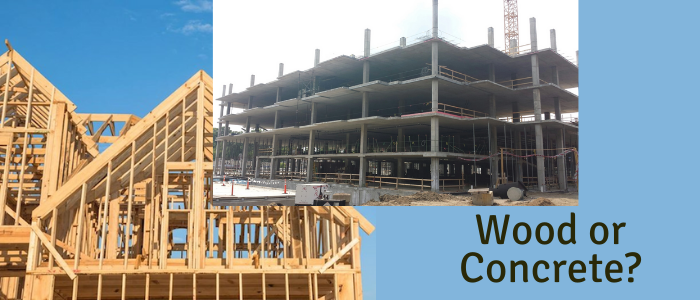We should understand that this questions has various perspectives which will affect how we look at the pros and cons of both. We also recognize the difference between short-term advantages and long-term benefits. By this, we mean that a material may give you benefits on the long run that may outweigh the drawbacks shows to day. While you are reading, you should keep your own priorities in mind.
Concrete
Concrete is the most popular material for construction in the world. In fact, it is the second used material after water. Concrete has numerous advantages that makes it very popular:
- Very durable
- Needs low maintenance
- Does not rust
- Retains heat so it increases the energy efficiency
- Resist fire
- Effective soundproofing material
Yet, concrete still shows some cons:
Disadvantages of Concrete
- More expensive
- Heavy & difficult to transport
- Takes time to build with
- Susceptible to salt efflorescence
- may be vulnerable to durability issues
Timber
Just like concrete, wood, or timber has its benefits and its drawbacks as a building material:
Advantages of Wood
- Light
- Easy to work with
- Takes less time in construction
- less costly
- Readily available since it is a natural resource
Disadvantages of Wood
- Can be a suitable spot for mold growth espcially if there is high moistures
- plenty of moisture can cause structural problems
- Vulnerable to fire
- Decays
Sustainability
Wood is a natural building material that is sustainable, and environmentally friendly. Wood stores carbon dioxide, which leads to a reduction of carbon dioxide emissions .
On contrary, concrete takes a lot of resources to produce. Cement is a major contributor to greenhouse gas emissions in the world. Many people hold the assumption that since cement production is harmful for the environment, concrete will be the same. But this point can not be totally true. Let’s have a look at the other side of the coin.
Concrete is durable—it has a service life that is 2-3 times longer than other common building materials. It provides better energy efficiency because it absorbs and retains heat, reducing the cost of heating systems. In addition, the reflective properties of concrete decreases the air-conditioning costs in the hot summers.
How about Safety?
Generally speaking, timber is not as safe as concrete. Wood is vulnerable when exposed to external threats like fire, wind, insects, moisture, and mold. Any of these things can cause a serious structural or safety problem.
Looking at concrete; while it is durable, it can cause some risk. When a concrete building collapse, falling concrete could seriously injure anyone who is nearby.
Now after you read this post, which one would you choose wood or concrete?
Share this:
- Click to share on Facebook (Opens in new window)
- Click to share on WhatsApp (Opens in new window)
- Click to share on Twitter (Opens in new window)
- Click to share on Pinterest (Opens in new window)
- Click to share on LinkedIn (Opens in new window)
- Click to share on Reddit (Opens in new window)
- Click to share on Tumblr (Opens in new window)
- Click to share on Pocket (Opens in new window)
- Click to share on Telegram (Opens in new window)
- Click to email a link to a friend (Opens in new window)
- Click to print (Opens in new window)
